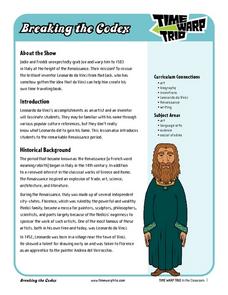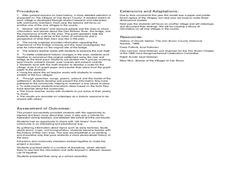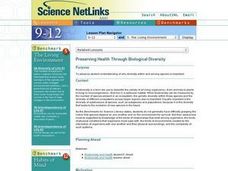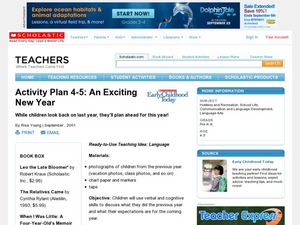Curated OER
Count, Trace, and Print Numbers 1 to 20
The first of these four pages deals with numerals 1 - 5, and subsequent pages cover the following sets of five numerals. For each, one or two dominoes display the number of spots, dotted lines with arrows instruct how to write the...
Curated OER
The Feudal System: Castles at War
Students study the feudal system of the Middle Ages. In this Middle Ages lesson, students watch "The Feudal System at War". Students listen to an instructor-delivered lecture regarding the roles of monarchs, nobles, knights, and...
Curated OER
Investigation of Immigration
Young scholars assume the role of a crime scene detective and examine the lives of various immigrant groups. In this immigration lesson, students examine evidence, websites, and pull from existing knowledge to determine which group they...
Curated OER
Is FEMA a Natural Disaster?
Students develop an understanding of FEMA and reflect about the consequences of a natural disaster. In this natural disaster lesson plan, students are asked specific questions after reading several stories. After class...
Curated OER
Breaking the Codex
Students work with an online multimedia show to study the life of Leonardo da Vinci in Renaissance Italy. They explore different writing systems and create an advertisement for one of Leonardo da Vinci's inventions.
Curated OER
Sense of Place: No River Too Wide-Bridges
Fifth graders discover the history of their hometown Des Moines River. In this U.S. Geography lesson students speak with Iowans that tell stories of the settlers and early villages near the Des Moines River. Students document...
Curated OER
Nonviolence the Road to Freedom
Eleventh graders discuss the use of nonviolence. In this civil rights movement lesson, 11th graders write a journal entry on the differences between Rosa Parks and Martin Luther King Jr., discuss nonviolence and create a poster...
Curated OER
Preserving Health Through Biological Diversity
Students research and explore the benefits of biodiversity, particularly as it relates to human health. They write an essay in which they explain the possible effect of human activities on the emergence of new diseases.
Curated OER
A Peaceful Place Is Powerful for the Mind
Fourth graders explore, analyze and interpret how schools can become peaceful places to learn and interact with others. They study a wide variety of avenues to achieve this task through classroom, community and career activities...
Curated OER
Light and Our World
In this science worksheet, students solve a variety of curriculum related puzzles. They also practice basic mental math skills using four operations. The concept of light and color are explored and how it interacts with different objects.
Curated OER
An Exciting New Year
Students look back on last year, so that they are able to plan ahead for a new year. In this early childhood language arts lesson, students use verbal and cognitive skills to discuss what they did the previous year and what their...
Curated OER
Activity Plan 5-6: Shape Transformers
Students expand their thinking while investigating shape and design. In this early childhood lesson plan, students transform a geometric shape into another shape or design to develop math and creative-thinking skills.
Curated OER
Activity Plan 5-6: Book-Character Homes
Students use their creativity to build character homes. For this early childhood lesson plan, students develop creative-thinking, social, language, math, and motor skills as they work together to create buildings for characters from...
Curated OER
"Split" Character Studies in Crime and Punishment
Young scholars write an essay evaluating split character traits on major characters in Dostoevsky's novel Crime and Punishment. In this lesson students are guided through discussion questions, group assignments, and vocabulary work. The...
Curated OER
Winter at Valley Forge
Students assess the events leading up to the American Revolution. For this United States History lesson, students read "Crossing the Delaware: George Washington Fights in the Battle of Trenton," then discuss the highlights in the story....
Curated OER
On the Other Hand
In this personal characteristics worksheet, students, with a partner, discuss the unusual characteristics that four famous people have in common and start a conversation with seven main questions about left-handed people.
Curated OER
Twentieth Century Entertainment: When Work is Done
Students determine how Americans enjoy leisure time. In this 20th century America lesson, students research primary sources to study how Americans gained leisure time during the century and what they did with it.
Pennsylvania Department of Education
Freckle Face
Students collect and record data. In this early data analysis lesson, students gather data about their partners face. As a class, the students use tally marks and pictographs to record the data and answer question about the information...
Curated OER
Mapmaker, Mapmaker, Make Me a Map!
Students evaluate the different types of historical and geographical information that one can gather through close study of historical maps from the 16th through the 19th centuries. They create their own maps.
Curated OER
Citizen Journalism
Students examine the role of citizen journalism, freedom of the press, and the First Amendment. They analyze the results of an Internet survey, discuss the ethics of downloading copyrighted material on the Internet, and write a news story.
Curated OER
In His Own Words: James Madison On the Problem of Faction
Students are introduced to the writings of James Madison and explain why he is often called "The Father of the Constitution". Using primary source documents, they examine his view of the Bill of Rights and what he meant by faction. In...
Curated OER
The Fable of Franny And Her Fabulous Fainting Goat
Mix the art of reading comprehension with the skill of telling time. Children in grades two and three will discuss the importance of goats throughout history based on the provided background information. They'll create cute goat...
Curated OER
Sea Urchin Embryology
Young scholars explore the process of evolution. They examine examples of how homeotic genes may work and obtain gametes. Using a microscope, students observe the fertilization of sea urchins. They video tape the process and write a...























